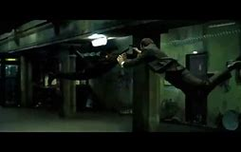What makes a great fight scene? Guns, explosions, one against many and the asskicking spree that follows? All fine suggestions, but if you’re planning on creating a memorable fight scene in your own work then I would advise focusing more on purpose than performance.
Now, before I start, I just want to explain the difference between a fight scene and an action scene. In fact, a good example of a movie that distinguishes between both very well is The Matrix. The, ‘Guns. Lots of guns’ lobby shootout was an action scene. As badass as it was, it didn’t really move the plot forward. We could have skipped the entire scene and cut to straight to the rooftop and the plot would not had changed at all. It was more a spectacle – eye candy, if you will – for we the audience to engage and be blown away by. As fun as it is to watch our heroes smash through endless swarms of enemies (and it is fun) you should be concerned that while all of this is going on, your plot is remaining static.
The subway station scene with Neo and Agent Smith is undoubtedly a fight scene – and a great one at that. It differs from an action scene because spectacle is not the primary objective of the seen, but rather narrative. The Matrix builds up this fight very well. We are told by Morpheus that every single person who has ever fought an Agent has died, when we see them in action, they are very strong and very foreboding. When Neo decides to stand up against him, we the audience are now engaged. This is going to be tough for our hero, the stakes are raised.

Keanu Reeves and Hugo Weaving going head to head.
BLOW BY BLOW VS CLARITY
In Bruce Lee’s martial arts classic, ‘Way of the Dragon’, the movie spends 9 minutes of it’s 2 hour’s and 13 minute runtime to show us a fight scene between Chuck Norris and Bruce Lee himself. This fight (which is badass, I might add) does more than show us some great action – it develops the characters too.
For the first few minutes of the fight, Chuck Norris pummels Lee with his superior height and physical strength, meaning that Lee has to reassess his strategy and for the next minute or so of the fight he defends and blocks the attacks of Norris he finds a suitable counterattack which finally results in Lee winning (of course). The reason this fight scene is so iconic in this movie (and in the martial arts genre in general) is that we the audience physical watch Lee learn, improve and adapt his style in order to defeat a stronger opponent. Again, the narrative takes precedent over the spectacle.
Focusing on narrative instead of aesthetics and violence, will give your fight scene clarity and a mental and emotional hook to hang of your punches or shootouts on. Treat every fight like a story within the story. Give them a beginning, middle and end. Have motivations change throughout and let us see these characters adapt to compensate for the other's strengths.
Focusing on narrative instead of aesthetics and violence, will give your fight scene clarity and a mental and emotional hook to hang of your punches or shootouts on. Treat every fight like a story within the story. Give them a beginning, middle and end. Have motivations change throughout and let us see these characters adapt to compensate for the other's strengths.
TELL YOUR STORY THROUGH KICKING ASS!
A good fight scene should do more than merely titillate, it should be the cathartic release that you have been building up in your audience up until this point. So, rather like telling a good joke, a good fight scene needs the appropriate build up before the delivery of the punch line.
This is why I would advise against beginning your story with an action or a fight scene. I know you think that it looks great and the reader will have no choice but to get sucked into your story, but it’s very unlikely to work out that way. The simple reason being; we don’t know anything about these characters so our engagement in any actions they perform (including taking out a room of 50 guys without breaking a sweat) is very limited at this point.
Make your audience care about your characters before you put them in peril or physical conflict. I’ll go into further detail on this in a future blog.
This is why I would advise against beginning your story with an action or a fight scene. I know you think that it looks great and the reader will have no choice but to get sucked into your story, but it’s very unlikely to work out that way. The simple reason being; we don’t know anything about these characters so our engagement in any actions they perform (including taking out a room of 50 guys without breaking a sweat) is very limited at this point.
Make your audience care about your characters before you put them in peril or physical conflict. I’ll go into further detail on this in a future blog.



